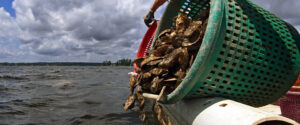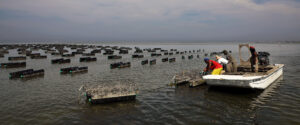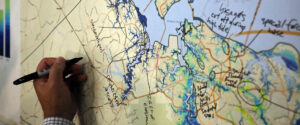GOVERNOR APPOINTS SEA GRANT DIRECTOR, UNIVERSITY PARTNERS TO VIRGINIA RESILIENCE ADVISORY COMMITTEE
For the 250,000 acres of land, 1,496 miles of roads, and $17.4 billion of property located less than five feet above the high tide line in Virginia, resilience to sea level rise and other natural hazards is of immediate concern. A new committee established by Governor Ralph Northam will help develop Virginia’s first Coastal Resilience Master Plan, a document that will coordinate and align regional resilience efforts across the Commonwealth.
The Virginia Coastal Resilience Technical Advisory Committee, led by Chief Resilience Officer and Secretary of Natural Resources Matthew Strickler, includes 24 representatives from academic institutions, coastal planning district commissions, and state agencies. Virginia Sea Grant Director Troy Hartley has been appointed to serve on the advisory committee, along with representatives from Sea Grant partner institutions: Virginia Coastal Policy Center Director Elizabeth Andrews from the William & Mary Law School, Environmental Resilience Institute Director Karen McGlathery from the University of Virginia, and Associate Dean of Research and Advisory Services Mark Luckenbach from the Virginia Institute of Marine Science.
“There’s a roadmap for the master plan now, but the next steps are where the rubber hits the road,” VASG Director Troy Hartley said. “Together with the committee members and our partner institutions, we’ll be able to reach across disciplines to address research needs that emerge during the process of creating the coastal master plan.”
The technical advisory committee will assist in identifying additional information needed for the coastal resilience master plan, and help coordinate resilience initiatives, policies, and funding opportunities across agencies and institutions, according to Ann Phillips, a retired Navy rear admiral and the special assistant to the governor for coastal adaptation and protection.
The Coastal Resilience Master Plan will build on the coastal resilience master planning framework approved in October 2020. The planning framework established the goals and guiding principles, placing an emphasis on acknowledging climate change, enhancing equity, prioritizing nature-based solutions, using region-specific approaches, and identifying cost-effective solutions for the four regions of coastal Virginia. The master plan will incorporate new funding sources such as the Virginia Community Flood Preparedness Fund and revenue from Virginia’s first auction as part of the Regional Greenhouse Gas Initiative.
“This innovative approach to coastal adaptation and protection was created based on the input and experience of state, federal, regional, and community stakeholders and experts,” Phillips said. “I look forward to engaging with communities across the coastal region as we continue to develop Virginia’s first Coastal Resilience Master Plan.”
The advisory committee held its first public meeting on Dec. 14 and plans to meet bi-monthly.
Photos by Aileen Devlin | Virginia Sea Grant
Published December 15, 2020.
“Together with the committee members and our partner institutions, we’ll be able to reach across disciplines to address research needs that emerge during the process of creating the coastal master plan,” Hartley said.





